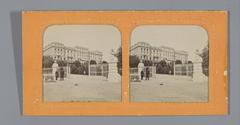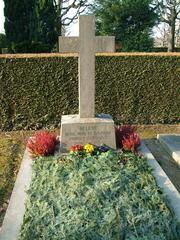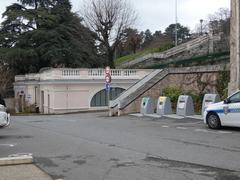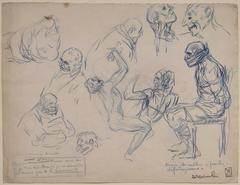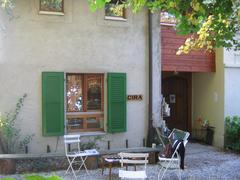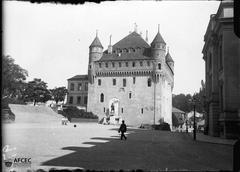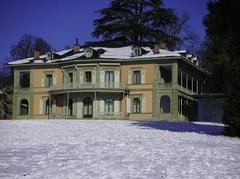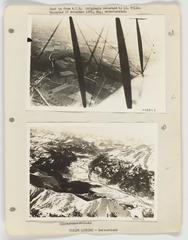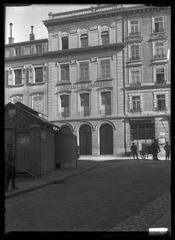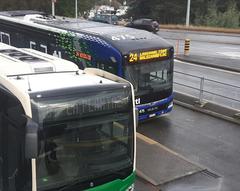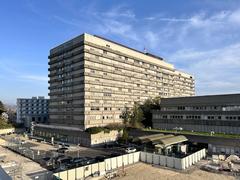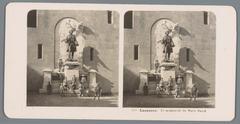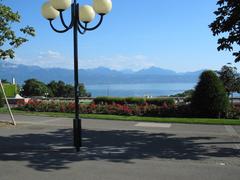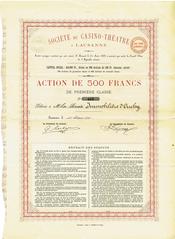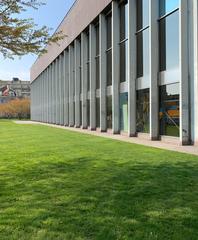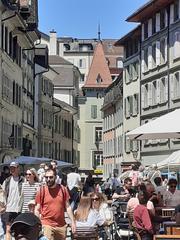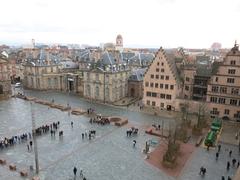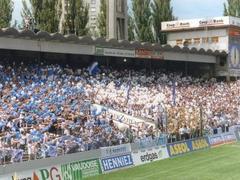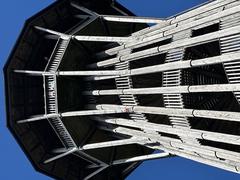Ancien Évêché De Lausanne: Visiting Hours, Tickets, and Travel Guide
Date: 04/07/2025
Introduction
The Ancien Évêché de Lausanne, or Old Bishop’s Palace, is a cornerstone of Lausanne’s medieval heritage and a vibrant cultural site today. Situated in the city’s historic district, next to the grand Lausanne Cathedral, this former episcopal palace reflects centuries of ecclesiastical power, civic evolution, and architectural transformation. Now home to the Musée Historique Lausanne, it invites visitors to explore Lausanne’s fascinating history through immersive exhibits and the very walls that have witnessed dramatic regional changes. This guide provides all the essential information for planning your visit, including opening hours, ticket details, site highlights, accessibility, and nearby attractions.
Table of Contents
- Introduction
- Historical Background
- Architectural Evolution and Features
- Political and Cultural Significance
- Restoration and Modern Use
- Visitor Information
- What to See at the Ancien Évêché
- Guided Tours and Educational Programs
- Special Events and Exhibitions
- Key Nearby Attractions
- Suggested Itineraries
- Practical Tips for Visiting
- Visitor Etiquette and Local Insights
- FAQs
- Visuals and Media
- Internal and External Links
- Conclusion and Call to Action
- References
Historical Background
The Ancien Évêché de Lausanne dates back to at least the 11th century, serving as the fortified residence and administrative center for the bishops of Lausanne (Wikipedia). Its proximity to Lausanne Cathedral allowed bishops to oversee both spiritual and secular affairs, making the palace a hub of governance and diplomacy in the region. In 1431, the episcopal seat moved to the newly constructed Château Saint-Maire, but the Ancien Évêché remained central to the city’s administration and civic life.
The palace’s function evolved dramatically after the Protestant Reformation in 1536, when the Catholic bishops were expelled and the building transitioned to secular uses. Over the centuries, it served as a hospital, school, courthouse, and prison, reflecting the changing needs and governance of Lausanne (SwissCastles).
Architectural Evolution and Features
The Ancien Évêché’s architecture is a palimpsest of Romanesque, Gothic, Renaissance, and Baroque elements. Its oldest sections display robust masonry and rounded arches typical of Romanesque design, while later additions incorporate Gothic verticality, Renaissance refinement, and Baroque details.
- Southwest Wing: The oldest part, with thick stone walls and vaulted ceilings, demonstrates 11th-century construction techniques.
- Grand Staircase and Reception Halls: Later renovations introduced high ceilings, decorative capitals, and painted beams, reflecting the palace’s ceremonial functions.
- Courtyards and Gardens: Terraced gardens and courtyards provide tranquil spots with panoramic views of Lausanne and Lake Geneva (lausanne.ch).
The building’s irregular plan follows the contours of the Cité hill, integrating seamlessly with the surrounding medieval cityscape.
Political and Cultural Significance
For centuries, the Ancien Évêché was the seat of both ecclesiastical and temporal power in Lausanne. It hosted synods, councils, and negotiations that shaped the region’s religious and political landscape. The building’s continued adaptation—from bishopric to civic institution—mirrors Lausanne’s transformation into a modern, dynamic city.
Since 1918, the palace has housed the Musée Historique Lausanne, preserving the city’s local history through collections of artifacts, portraits, documents, and historical models, including the monumental Buttet Plan of 1638 (Audiala).
Restoration and Modern Use
The Ancien Évêché underwent major restoration in the 20th century, particularly between 1909 and 1917 under architect Otto Schmid, to preserve its historical integrity while accommodating new functions. Subsequent renovations expanded museum space and improved accessibility, ensuring that the building remains both a heritage monument and a vibrant cultural venue (SwissCastles).
Visitor Information
Visiting Hours and Tickets
- Opening Hours: Tuesday to Sunday, 10:00 AM to 6:00 PM. Closed Mondays and certain public holidays.
- Admission: Adults CHF 8, seniors and students CHF 5, children under 16 free. Discounts for groups; free entry on special days.
- Tickets: Purchase onsite or online through the official museum website.
Accessibility
The museum is committed to accessibility, with ramps, elevators, and tactile maps for visitors with reduced mobility. Some upper floors may have limited access due to the building’s historic structure; inquiries in advance are recommended (Audiala).
Getting There
Located in the heart of Lausanne’s Old Town, the Ancien Évêché is best reached on foot or via public transport. The nearest metro station is “Lausanne-Flon,” with a 10-minute walk uphill to Place de la Cathédrale. Parking is limited; public transit is advised.
What to See at the Ancien Évêché
- Permanent Exhibitions: Trace Lausanne’s evolution through local artifacts, portraits, historic documents, and city models.
- Temporary Exhibitions: Themed displays on aspects of Lausanne’s history and culture.
- Architectural Highlights: Double staircase, grand attic hall, spiral staircase, and restored medieval features.
- Scenic Views: The palace and nearby esplanade offer vistas over the city and Lake Geneva (Lonely Planet).
Guided Tours and Educational Programs
Guided tours are offered in French, with some availability in English and German. These tours provide deeper context on the building’s history and city development. Educational programs engage schools and families, making the site an excellent resource for learning.
Special Events and Exhibitions
The Ancien Évêché regularly hosts temporary exhibitions, workshops, public lectures, and participates in citywide events such as European Heritage Days and the Nuit des Musées, often with extended hours and special activities (Lausanne Tourisme).
Key Nearby Attractions
- Lausanne Cathedral: Switzerland’s iconic Gothic monument, offering panoramic tower views.
- Escaliers du Marché: A covered, medieval stairway linking the cathedral to Place de la Palud.
- Place de la Palud: The heart of Old Town, with an animated clock, historic town hall, and lively markets.
- Flon District: Lausanne’s arts and nightlife hub, a short walk away.
- Ouchy Waterfront: Lake Geneva promenade with boat rides, gardens, and the Olympic Museum.
- Tour de Sauvabelin: Wooden observation tower with sweeping views.
- Lavaux Vineyards: UNESCO World Heritage site, accessible by public transport (PlanetWare).
Suggested Itineraries
Half-Day Itinerary
- Musée Historique Lausanne (Ancien Évêché)
- Lausanne Cathedral
- Escaliers du Marché to Place de la Palud
- Snack at the museum’s buvette
Full-Day Itinerary
- Old Town exploration in the morning
- Lunch in Flon District
- Afternoon at Ouchy and the Olympic Museum
- Optional boat trip on Lake Geneva
Two-Day Itinerary
- Day 1: Old Town and city center (including Ancien Évêché, Cathedral, Flon)
- Day 2: Nature and lake (Tour de Sauvabelin, Ouchy, Lavaux or Château de Chillon)
Practical Tips for Visiting
- Wear comfortable shoes; Lausanne’s Old Town has cobblestones and hills.
- Museums are usually closed Mondays; check hours in advance.
- The Lausanne City Pass offers discounted or free museum entries and public transport.
- Dining options abound in Old Town and Flon; lakeside cafés are ideal in summer.
- For accessibility needs, contact the museum ahead of your visit.
Visitor Etiquette and Local Insights
- Respect museum guidelines and avoid touching artifacts.
- French is the main language, but English is widely spoken in tourist areas.
- The Old Town is especially charming in spring and autumn, with fewer crowds.
FAQs
What are the Ancien Évêché de Lausanne visiting hours?
Tuesday to Sunday, 10:00 AM–6:00 PM; closed Mondays and holidays.
How much do tickets cost?
CHF 8 for adults, CHF 5 for seniors and students, free for children under 16.
Is the museum wheelchair accessible?
Key areas are accessible, but upper floors may be limited; contact the museum for details.
Are guided tours available?
Yes, in French regularly and in English/German by appointment.
Can I buy tickets online?
Yes, via the official museum site.
Visuals and Media
Explore virtual tours, interactive maps, and high-quality images on the official museum website. Images include descriptive alt text for accessibility and SEO, such as “Romanesque arches at Ancien Évêché Lausanne” and “Panoramic view over Lake Geneva from Ancien Évêché.”
Internal and External Links
- Musée Historique de Lausanne Official Site
- Audiala Lausanne Museum Guide
- Lausanne Tourist Information
- Wikipedia: Ancien Évêché de Lausanne
- SwissCastles
- PlanetWare
- Lonely Planet
- Lausanne Heritage Guide
Conclusion and Call to Action
The Ancien Évêché de Lausanne is a unique fusion of history, architecture, and culture—a must-see for anyone exploring Lausanne. Its preservation and adaptive reuse as a museum reflect the city’s resilience and cultural vitality. Plan your visit by checking the latest hours and ticket information on the official website and enhance your experience with the Audiala app for audio guides and virtual tours. Stay connected via social media for updates on exhibitions and events, and make the most of your time in Lausanne by exploring the many nearby attractions.
